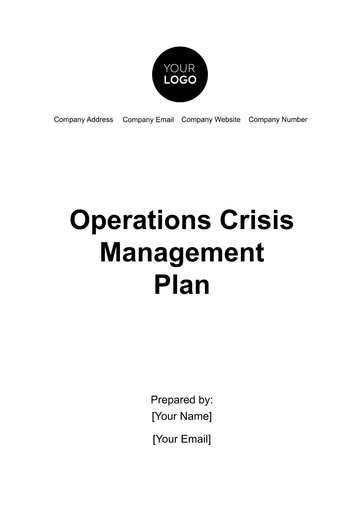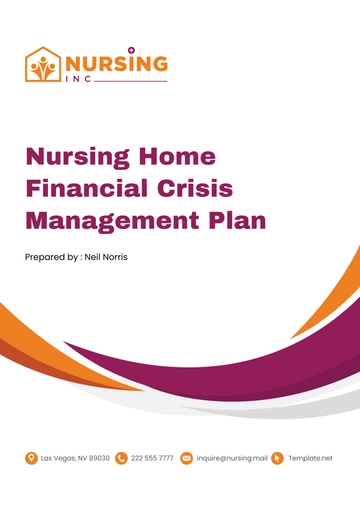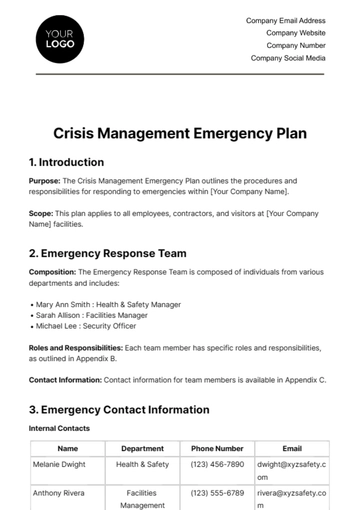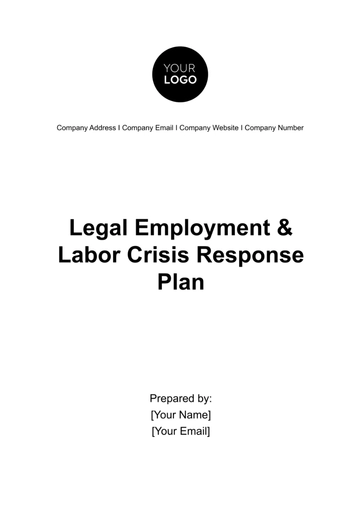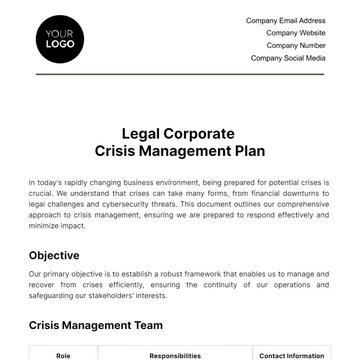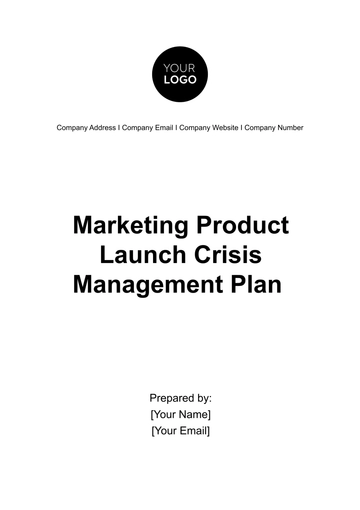Free Startup Financial Crisis Management Plan

I. Introduction
A. Purpose of the Plan
Navigating Uncertainty: Our foremost objective is to provide our startup with a robust framework for navigating uncertainty during financial crises. This plan acts as a proactive tool, enabling us to anticipate, identify, and address potential financial pitfalls before they escalate.
Ensuring Long-Term Viability: Beyond immediate crisis response, our plan is designed to safeguard the long-term viability of our startup. Through targeted strategies and resilient recovery plans, we aim not only to weather the storm but to emerge stronger and more resilient.
B. Significance of the Plan
Preserving Stakeholder Confidence: We recognize the pivotal role of financial crisis management in preserving the trust and confidence of our investors, customers, employees, and other stakeholders. Building and maintaining their trust is crucial during challenging times.
Strategic Decision-Making: Our plan empowers our leadership team to make informed decisions strategically. It guides us in prioritizing key areas, allocating resources effectively, and mitigating the impact of the crisis through well-thought-out strategies.
Maintaining Operational Continuity: Operational disruptions during a financial crisis can have severe consequences. Our plan emphasizes the importance of maintaining operational continuity to ensure that critical business functions continue seamlessly despite the challenges.
C. Proactive Approach
Anticipation and Preparedness: Acknowledging financial crises as inherent risks, our plan advocates for a proactive approach centered on anticipation and preparedness. By identifying potential triggers and developing preemptive strategies, we position ourselves to respond swiftly and effectively.
Strategic Agility: Emphasizing the need for strategic agility, our plan encourages us to be adaptable in the face of evolving financial circumstances. This includes the ability to pivot, reallocate resources, and make timely adjustments based on ongoing assessments.
II. Identified Financial Crisis
Upon conducting a comprehensive evaluation of our startup's financial landscape, we've discerned specific crises that could significantly impact our stability and long-term sustainability. The following provides a detailed breakdown, encompassing the nature, extent, and root causes of each crisis, serving as the foundation for a nuanced recovery plan.
A. Financial Crisis Categories
Revenue Shortfalls
Nature: Unforeseen drops in revenue, stemming from market fluctuations, customer attrition, or external economic factors.
Extent: Such drops will reverberate through our cash flow and liquidity, directly influencing our operational capabilities.
Root Causes: The unpredictability of the market, shifts in consumer behavior, or broader economic downturns contributes to this crisis category.
Operational Disruptions
Nature: Potential disruptions in our daily operations, arising from supply chain issues, technological failures, or unforeseen events.
Extent: These disruptions hold the potential to ripple through our productivity, affecting delivery timelines and overall operational efficiency.
Root Causes: Vulnerabilities in the supply chain, technological malfunctions, or external events beyond our immediate control contribute to this crisis.
Increased Debt Burden
Nature: The escalation of debt, potentially straining our financial resources and impeding our ability to invest in growth or respond to market changes.
Extent: This burden could lead to financial instability, limiting our strategic flexibility in the ever-evolving market landscape.
Root Causes: Aggressive expansion strategies, high-interest rates, or unfavorable economic conditions are contributing factors to the heightened debt levels.
Market Volatility
Nature: The potential for fluctuations in market conditions that may impact the valuation of our assets and the overall stability of the market.
Extent: Our startup's financial health is intricately linked to market dynamics, rendering us susceptible to sudden shifts.
Root Causes: Economic downturns, geopolitical events, or industry-specific challenges contribute to the inherent volatility in the market.
B. Impact Assessment
Short-Term Impact
The immediate consequences of these financial crises will manifest in our cash flow, liquidity, and day-to-day operations, necessitating swift and targeted responses.
Long-Term Implications
The enduring effects on our financial health and sustainability demand a strategic recovery plan that addresses both immediate and future consequences.
C. Root Cause Analysis
Internal Factors
Delving deeper into factors within our control, such as operational efficiency and debt management, provides insights for targeted interventions and strategic adjustments.
External Factors:
Analyzing external forces, including market conditions, economic trends, and geopolitical influences, affords us the foresight to anticipate and navigate challenges beyond our immediate sphere of influence.
D. Risk Mitigation Strategies
Revenue Diversification
Exploring new markets and customer segments is imperative to reduce dependence on specific revenue streams and enhance overall resilience.
Operational Redundancies
Implementing comprehensive backup plans and redundancies within our operations ensures a proactive response to potential disruptions, minimizing downtime and maintaining efficiency.
Debt Restructuring
Exploring various options for debt restructuring or refinancing becomes crucial to alleviate the financial burden and enhance flexibility in strategic decision-making.
Market Intelligence
Investing in advanced market intelligence capabilities equips us with the foresight to anticipate and navigate market volatility effectively, allowing for informed and strategic decision-making.
III. Recovery Plan
In response to the identified financial crises, a detailed Recovery Plan has been formulated, featuring tailored strategies for each crisis category. The table below outlines specific actions, timelines, and responsible parties to guide our startup through these challenging times:
Crisis Category | Strategies | Implementation Timeline | Responsible Party |
|---|---|---|---|
Revenue Shortfalls |
| Immediate to 6 months | Chief Marketing Officer |
Addressing revenue shortfalls, a critical aspect of our startup's recovery plan. The outlined strategies include diversifying revenue streams and optimizing marketing costs, indicating a proactive approach to both expanding income sources and ensuring cost-efficiency. The urgency of this initiative is underscored by the immediate to six-month implementation timeline, emphasizing the need for swift action to mitigate the impact on cash flow. The Chief Marketing Officer is assigned as the responsible party, highlighting the leadership and expertise required to navigate the complexities of marketing strategies. This strategic focus on revenue shortfalls demonstrates a commitment to financial agility, adaptability, and innovation, crucial for sustaining the startup's operational capabilities and ensuring long-term financial health.
This recovery plan is a comprehensive framework for addressing financial crises. It plays a pivotal role in guiding our startup through uncertain times. By outlining specific strategies, timelines, and assigning responsible parties, this ensures a structured and proactive approach to crisis management. It is significant in providing a roadmap that not only addresses immediate challenges but also establishes a foundation for long-term financial resilience and sustainability. It emphasizes adaptability, accountability, and collaboration, fostering a strategic mindset within the organization to navigate uncertainties and secure the startup's financial well-being.
IV. Budget
Budget creation plays a crucial role in stabilizing the financial condition. The graph below provides a comprehensive breakdown of financial allocations across key areas, reflecting a nuanced approach to crisis management:
Urgent fixes, allocated at $10,000, underscore the immediate financial needs that demand swift and targeted intervention to stabilize the startup's financial condition. The allocation for resource reallocation, set at $15,000, signifies a proactive effort to strategically reallocate resources where they can have the most significant impact, allowing for adaptability in responding to crisis-induced shifts. With $20,000 dedicated to debt repayments, the budget embraces a responsible approach to managing existing financial liabilities, ensuring financial sustainability amidst uncertainty. The allocation of $5,000 for planned expansions reveals a forward-thinking strategy, highlighting the startup's commitment to positioning itself for future growth even in the face of immediate challenges. The total budget of $50,000 reflects a judicious distribution of financial resources, balancing the urgency of immediate fixes with the imperative to fortify the foundation for long-term resilience.
V. Communication Plan
Transparent communication is crucial during times of financial crisis to build stakeholder confidence, dispel rumors, and facilitate the successful implementation of the recovery plan. The following table showcases our plan to ensure effective communication:
Communication Component | Description | Channel | Frequency |
|---|---|---|---|
Stakeholder Engagement | Regular updates on recovery plan progress to build and maintain stakeholder confidence. | Company Newsletter | Monthly |
Effective communication is vital for maintaining stakeholder trust, managing expectations, and ensuring a coordinated response to the challenges at hand. This plan aims to provide a structured framework for communication strategies, offering clarity on channels and frequencies. It fosters a culture of openness and information sharing within the organization, creating a resilient environment that can adapt to changing circumstances. By establishing reliable communication channels and frequencies, the plan contributes to a cohesive and informed organizational response, reinforcing the overall resilience of the startup during financial crises.
Our Communication Plan includes Stakeholder Engagement, emphasizing regular updates on the progress of the recovery plan through the company newsletter. This strategic approach aims to build and maintain stakeholder confidence during times of financial crisis. By utilizing the company newsletter as the communication channel, the organization ensures a centralized and reliable source of information for stakeholders. The choice of a monthly frequency reflects a commitment to consistent and timely updates, providing stakeholders with a predictable rhythm of information. This approach not only fosters transparency but also allows stakeholders to stay informed about the ongoing efforts to address financial challenges, ultimately reinforcing trust and understanding.
VI. Monitoring the Plan
A. Progress Review Mechanism
Establishing a robust mechanism for reviewing the progress of the plan is essential. This involves implementing regular team meetings, which serve as a platform for discussing the plan's status, addressing emerging challenges, and ensuring ongoing alignment among team members. Additionally, defining and monitoring Key Performance Indicators (KPIs) relevant to the plan's objectives is crucial. These KPIs act as quantitative metrics that enable an objective assessment of the plan's effectiveness, offering insights into areas of success and those that may require further attention.
B. Amendments and Adjustments
Given the dynamic nature of financial crises, the plan should allow for necessary amendments and adjustments. This involves integrating specific components to ensure flexibility and responsiveness.
Built-in Flexibility: Designing the plan with inherent flexibility ensures its adaptability to unforeseen changes or evolving crisis scenarios. This flexibility acknowledges the dynamic nature of financial crises and allows for real-time adjustments without compromising the overall integrity of the plan.
Trigger Points for Review: Establishing trigger points that prompt a systematic review and potential adjustment of the plan based on predefined criteria. These trigger points act as strategic milestones, signaling the need for a thorough evaluation to assess whether the plan remains aligned with the evolving nature of the crisis and organizational objectives.
Scenario Planning: Incorporating scenario planning as a proactive measure to anticipate potential shifts in the crisis landscape. By outlining alternative scenarios and corresponding response strategies, the plan becomes better equipped to navigate various crisis trajectories, enhancing its resilience in the face of uncertainty.
C. Stakeholder Communication
Maintaining transparent communication with stakeholders is crucial for fostering trust and keeping them informed throughout the crisis. This involves providing stakeholders with regular updates on the plan's progress, successes, and any necessary adjustments. The implementation of a feedback mechanism further enhances communication by actively soliciting insights from stakeholders. This two-way communication approach not only keeps stakeholders informed but also ensures that their perspectives are considered in the ongoing decision-making process, contributing to a more collaborative and supportive crisis response.
D. Evaluation of Key Decisions
Evaluating the effectiveness of key decisions made during the crisis is vital for continuous improvement. This includes conducting post-implementation reviews to assess the impact of key decisions and identify areas for enhancement. Treating challenges as learning opportunities is integral to this process, allowing the organization to extract valuable insights from both successful and challenging outcomes. Incorporating these lessons into future decision-making processes ensures a more informed and adaptive approach to addressing the complexities of the financial crisis.
- 100% Customizable, free editor
- Access 1 Million+ Templates, photo’s & graphics
- Download or share as a template
- Click and replace photos, graphics, text, backgrounds
- Resize, crop, AI write & more
- Access advanced editor
Be well-prepared to navigate financial crises and safeguard your startup's long-term success! Ensure the resilience of your startup with Template.net’s editable Startup Financial Crisis Management Plan Template! This customizable plan provides a tailored approach to crisis mitigation. Use the AI Editor Tool aligning the plan for your startup's security immediately!
You may also like
- Finance Plan
- Construction Plan
- Sales Plan
- Development Plan
- Career Plan
- Budget Plan
- HR Plan
- Education Plan
- Transition Plan
- Work Plan
- Training Plan
- Communication Plan
- Operation Plan
- Health And Safety Plan
- Strategy Plan
- Professional Development Plan
- Advertising Plan
- Risk Management Plan
- Restaurant Plan
- School Plan
- Nursing Home Patient Care Plan
- Nursing Care Plan
- Plan Event
- Startup Plan
- Social Media Plan
- Staffing Plan
- Annual Plan
- Content Plan
- Payment Plan
- Implementation Plan
- Hotel Plan
- Workout Plan
- Accounting Plan
- Campaign Plan
- Essay Plan
- 30 60 90 Day Plan
- Research Plan
- Recruitment Plan
- 90 Day Plan
- Quarterly Plan
- Emergency Plan
- 5 Year Plan
- Gym Plan
- Personal Plan
- IT and Software Plan
- Treatment Plan
- Real Estate Plan
- Law Firm Plan
- Healthcare Plan
- Improvement Plan
- Media Plan
- 5 Year Business Plan
- Learning Plan
- Marketing Campaign Plan
- Travel Agency Plan
- Cleaning Services Plan
- Interior Design Plan
- Performance Plan
- PR Plan
- Birth Plan
- Life Plan
- SEO Plan
- Disaster Recovery Plan
- Continuity Plan
- Launch Plan
- Legal Plan
- Behavior Plan
- Performance Improvement Plan
- Salon Plan
- Security Plan
- Security Management Plan
- Employee Development Plan
- Quality Plan
- Service Improvement Plan
- Growth Plan
- Incident Response Plan
- Basketball Plan
- Emergency Action Plan
- Product Launch Plan
- Spa Plan
- Employee Training Plan
- Data Analysis Plan
- Employee Action Plan
- Territory Plan
- Audit Plan
- Classroom Plan
- Activity Plan
- Parenting Plan
- Care Plan
- Project Execution Plan
- Exercise Plan
- Internship Plan
- Software Development Plan
- Continuous Improvement Plan
- Leave Plan
- 90 Day Sales Plan
- Advertising Agency Plan
- Employee Transition Plan
- Smart Action Plan
- Workplace Safety Plan
- Behavior Change Plan
- Contingency Plan
- Continuity of Operations Plan
- Health Plan
- Quality Control Plan
- Self Plan
- Sports Development Plan
- Change Management Plan
- Ecommerce Plan
- Personal Financial Plan
- Process Improvement Plan
- 30-60-90 Day Sales Plan
- Crisis Management Plan
- Engagement Plan
- Execution Plan
- Pandemic Plan
- Quality Assurance Plan
- Service Continuity Plan
- Agile Project Plan
- Fundraising Plan
- Job Transition Plan
- Asset Maintenance Plan
- Maintenance Plan
- Software Test Plan
- Staff Training and Development Plan
- 3 Year Plan
- Brand Activation Plan
- Release Plan
- Resource Plan
- Risk Mitigation Plan
- Teacher Plan
- 30 60 90 Day Plan for New Manager
- Food Safety Plan
- Food Truck Plan
- Hiring Plan
- Quality Management Plan
- Wellness Plan
- Behavior Intervention Plan
- Bonus Plan
- Investment Plan
- Maternity Leave Plan
- Pandemic Response Plan
- Succession Planning
- Coaching Plan
- Configuration Management Plan
- Remote Work Plan
- Self Care Plan
- Teaching Plan
- 100-Day Plan
- HACCP Plan
- Student Plan
- Sustainability Plan
- 30 60 90 Day Plan for Interview
- Access Plan
- Site Specific Safety Plan






